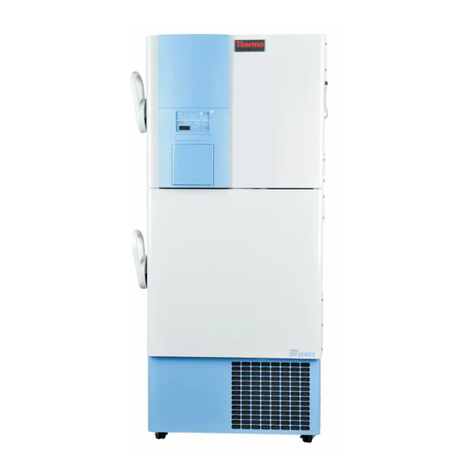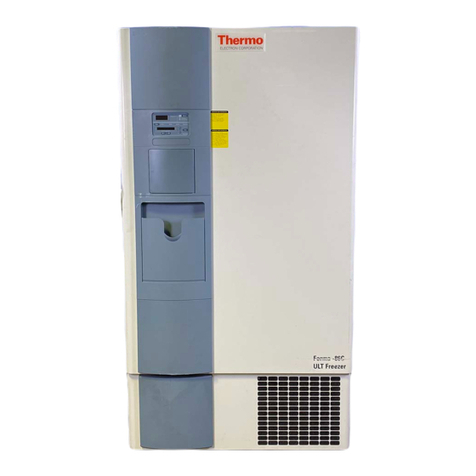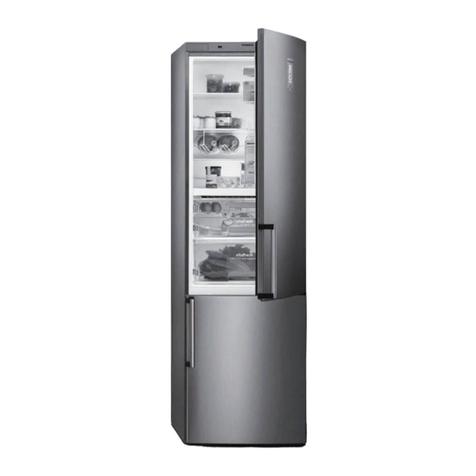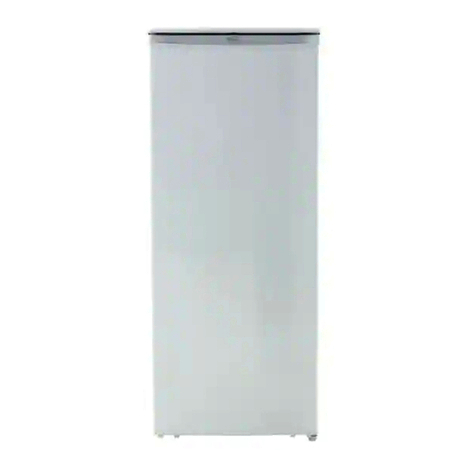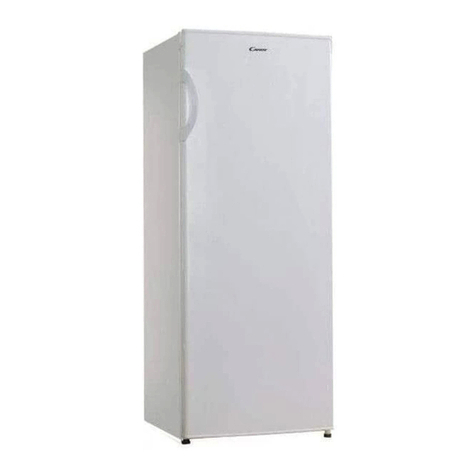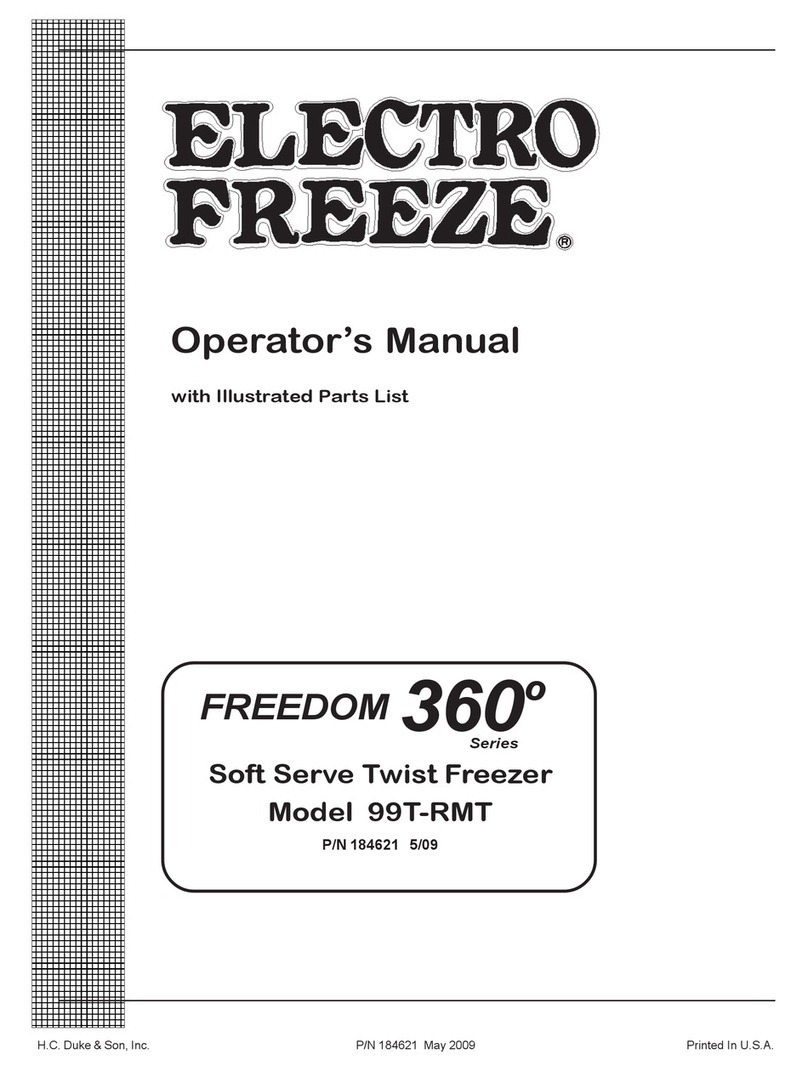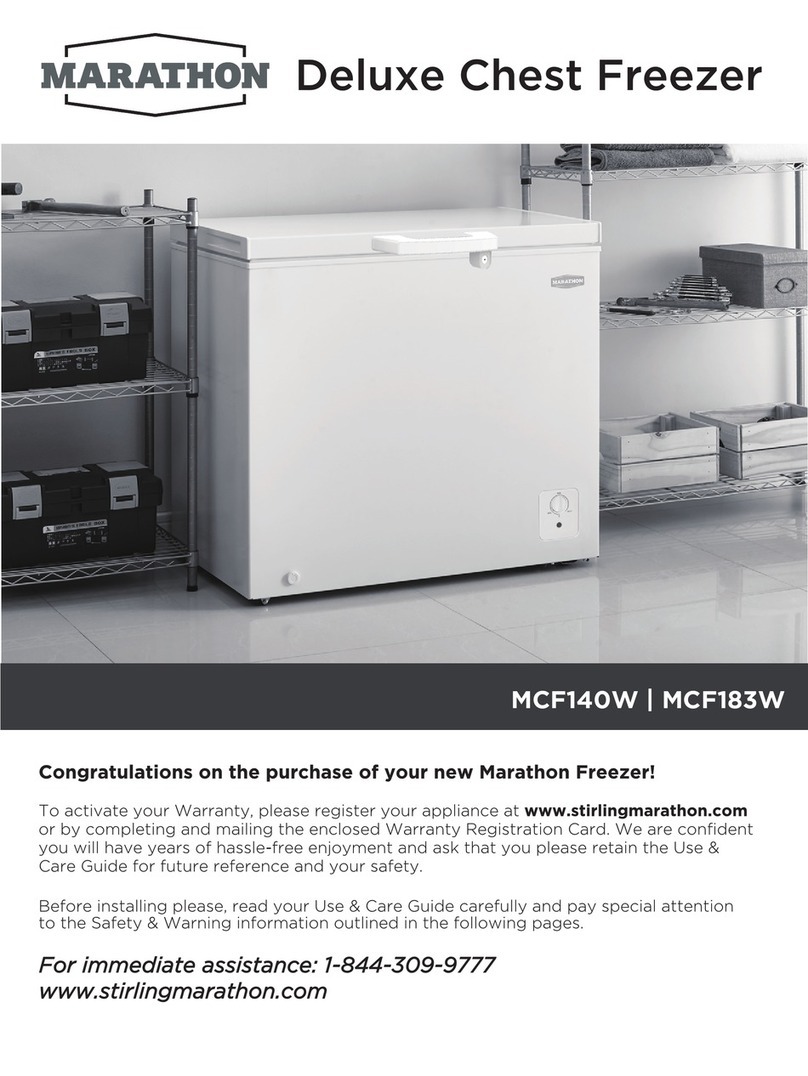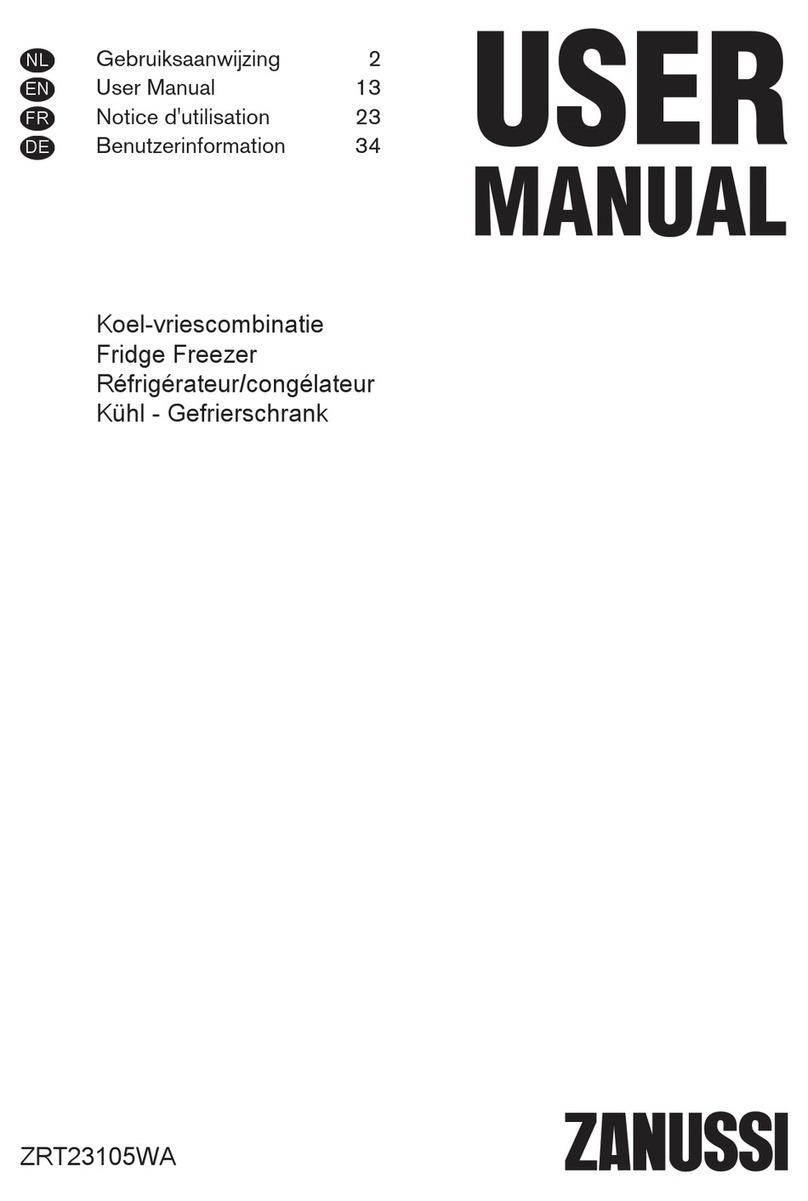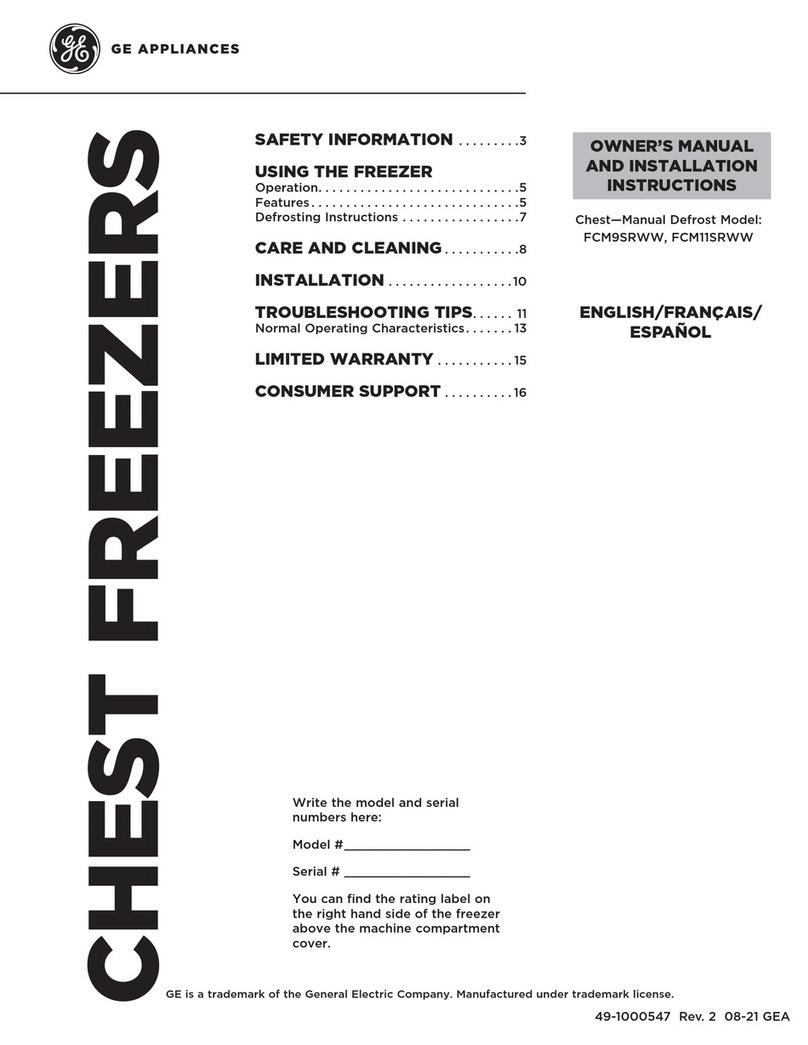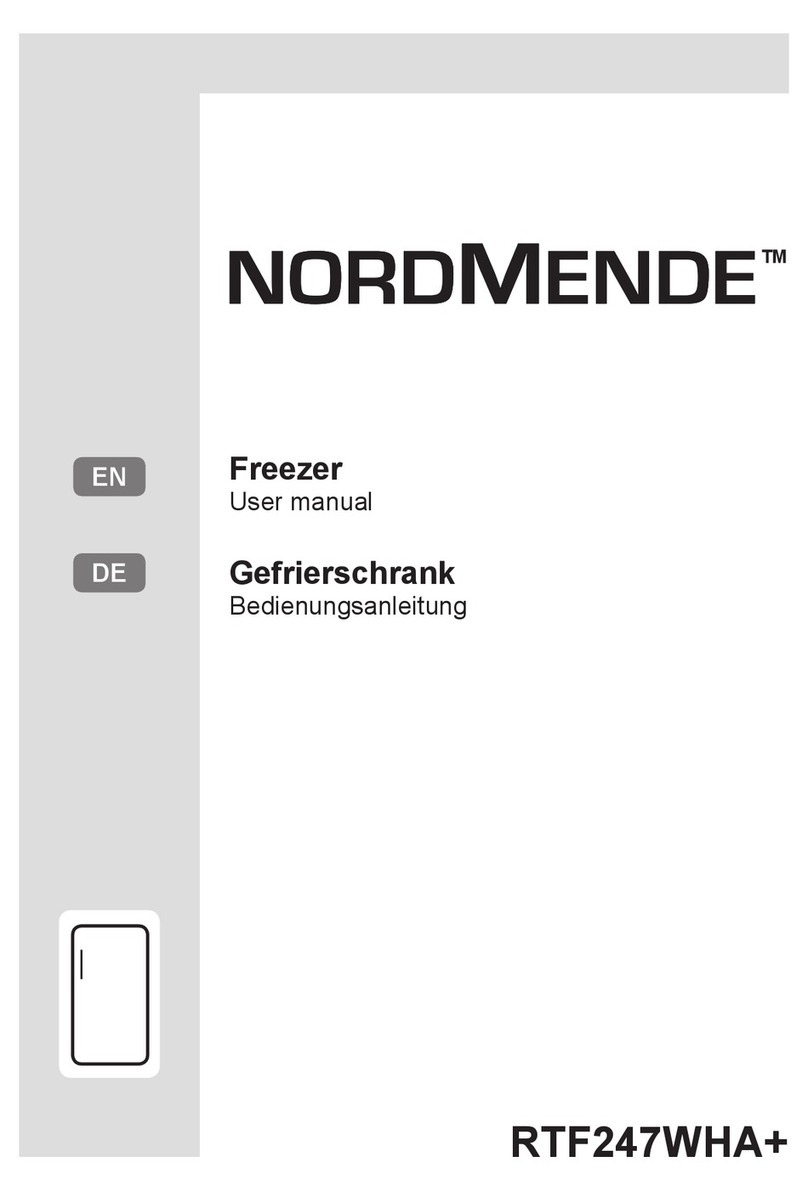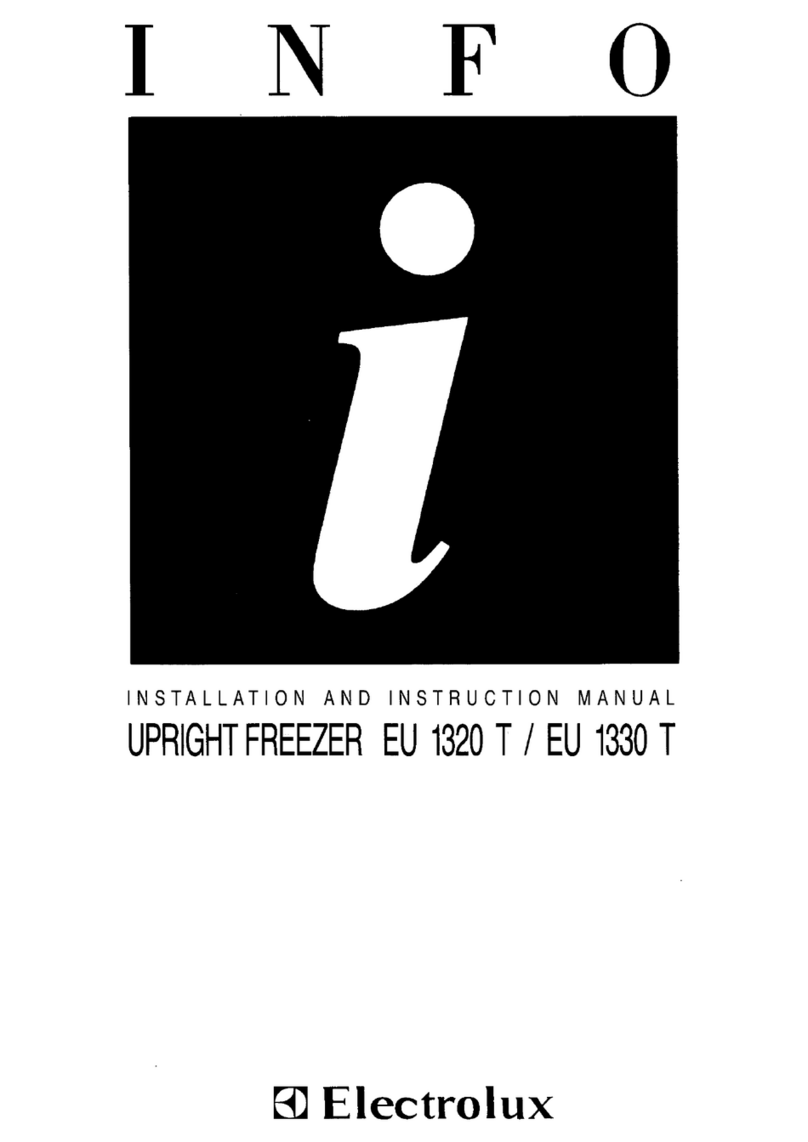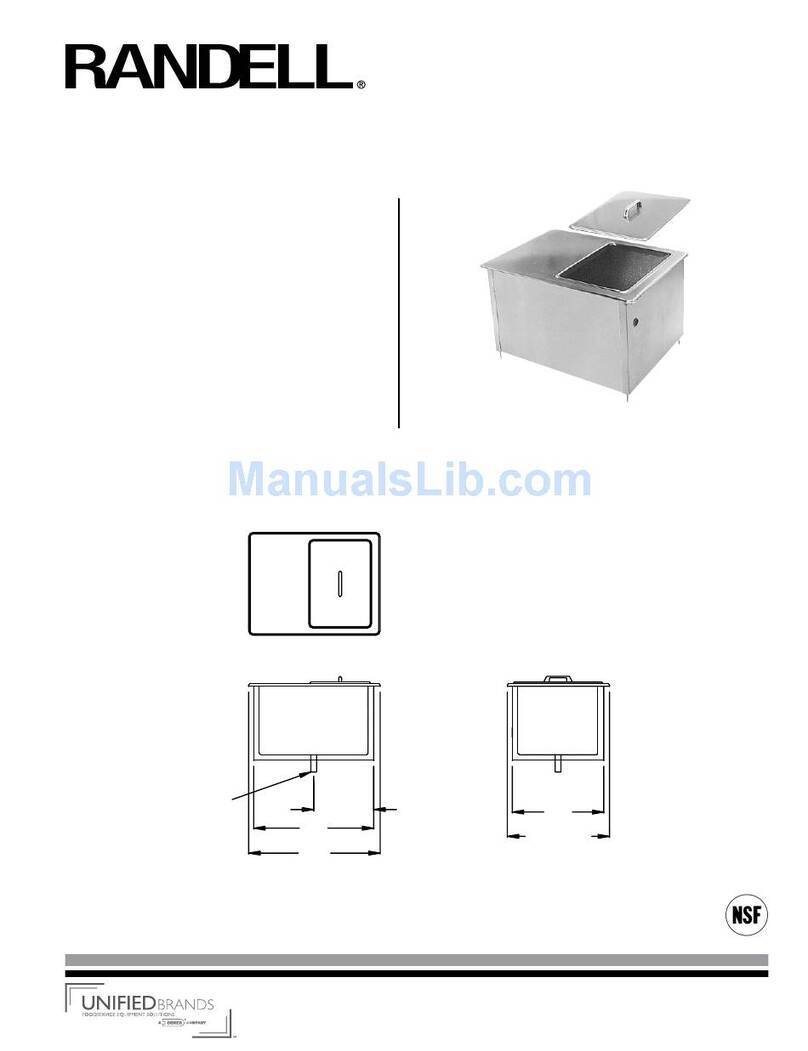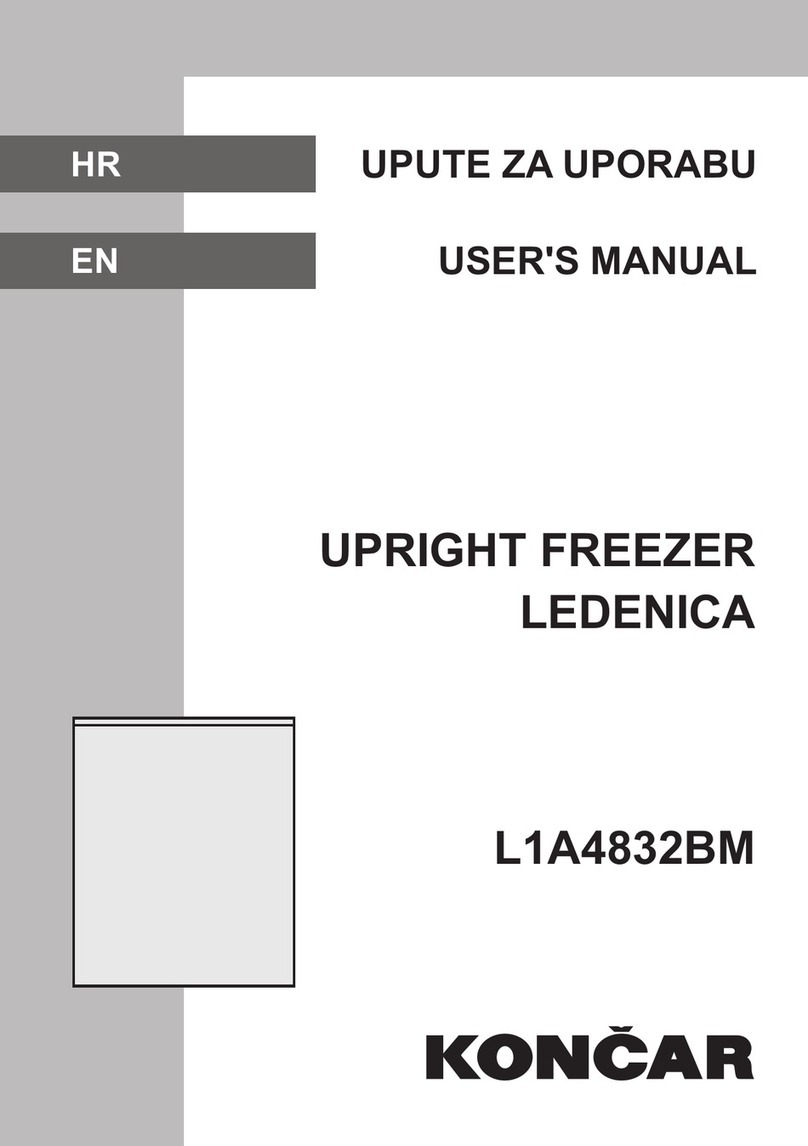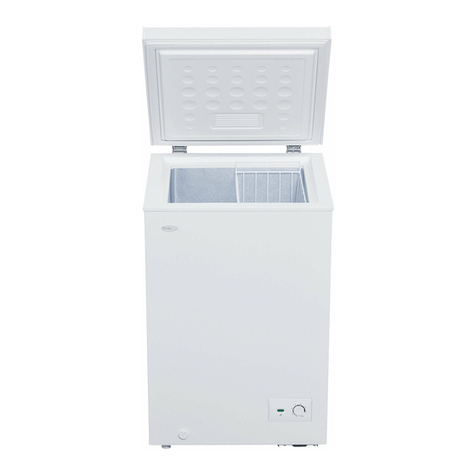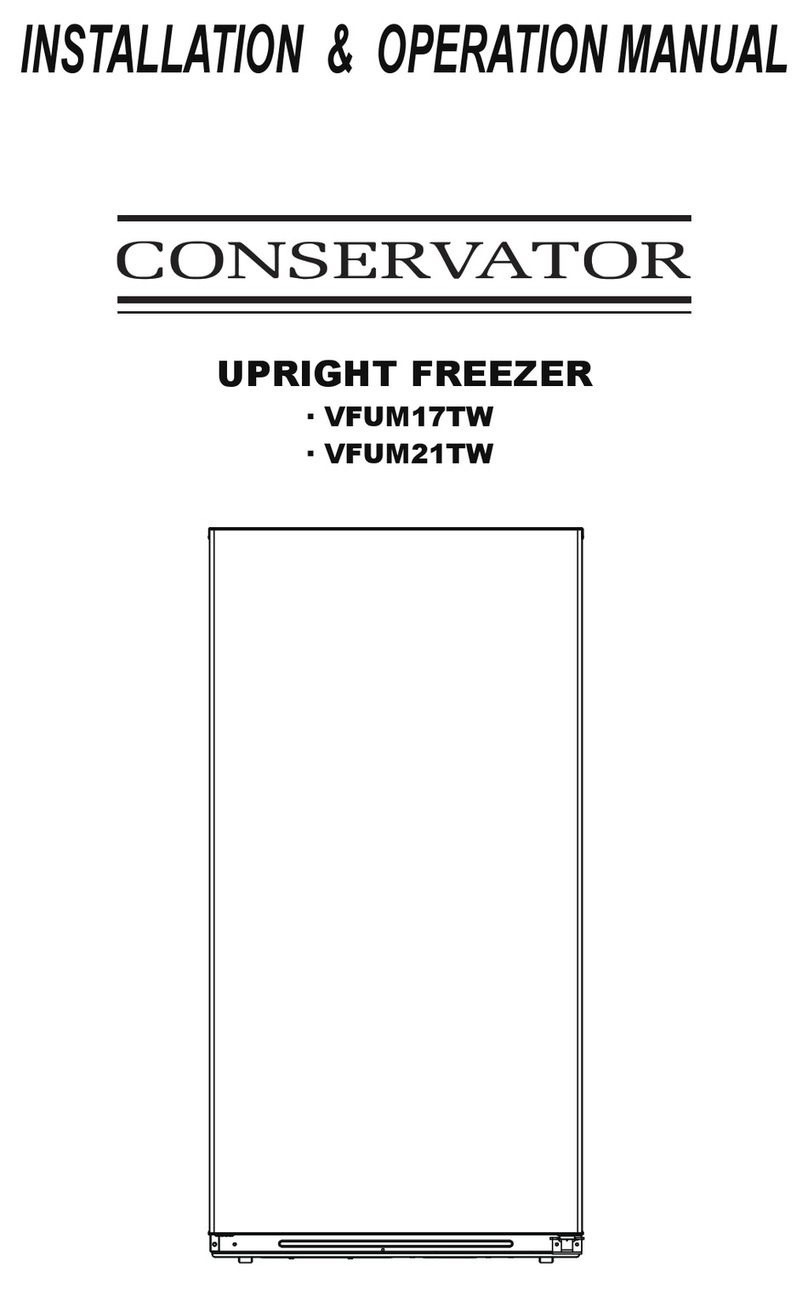Thermo Electron 8600 Series Operating instructions

8600 Series
Forma -86C ULT Freezer
Operating and Maintenance Manual
Manual No: 7018602 Rev. 3

8600 Series _______________________________________________________________________________
i
Read This Instruction Manual.
Failure to read, understand and follow the instructions in
this manual may result in damage to the unit, injury to operat-
ing personnel, and poor equipment performance.
CAUTION! All internal adjustments and maintenance must
be performed by qualified service personnel.
Refer to the serial tag on the back of this manual.
The material in this manual is for information purposes only. The
contents and the product it describes are subject to change with-
out notice. Thermo Electron Corporation makes no representa-
tions or warranties with respect to this manual. In no event shall
Thermo be held liable for any damages, direct or incidental, aris-
ing out of or related to the use of this manual.
MANUAL NUMBER 7018602
-- -- 5/12/04 Additional vacuum relief information aks
3 22216/22217/22179 3/17/04 Added models 8656 and 8690/PM updates/updated schematics aks
2 21886 9/22/03 Vacuum relief port aks
-- 21800 9/8/03 Revised refrigeration schematics aks
1 21795 8/12/03 Revised BUS operation instructions aks
-- 21396/21425 6/19/03 Revised parts drawings aks
-- 21605 5/8/03 Wrong power alarm modifications aks
-- 21526 5/8/03 Solenoid valve mounting bracket aks
0 FR-1698 3/26/03 New Release aks
REV ECR/ECN DATE DESCRIPTION By
Model Capacity in
Cubic Feet Voltage
8602 13 230
8603 13 120
8604 17 120
8605 17 230
8606 23 230
8607 28 230
8656 23 120
Double Door Units
8690 23 120
8691 13 230
8692 13 120
8693 17 120
8694 17 230
8695 23 230
Red Cell Storage
8627 13 230

8600 Series _________________________________________________________________________Warnings
ii
Important operating and/or maintenance instructions. Read the accompanying text carefully.
Potential electrical hazards. Only qualified persons should perform procedures associated with this symbol.
Hot surface(s) present which may cause burns to unprotected skin or to materials which may be damaged by elevated
temperatures
Extreme temperature hazards, hot or cold. Use special handling equipment or wear special, protective clothing.
√ Always use the proper protective equipment (clothing, gloves, goggles, etc.)
√ Always dissipate extreme cold or heat and wear protective clothing.
√ Always follow good hygiene practices.
√ Each individual is responsible for his or her own safety.

8600 Series ___________________________________________________________________________Service
iii


8600 Series __________________________________________________________________Table of Contents
iv
Table of Contents
Section 1 - Installation and Start-up . . . . . . . . . . . . . . .1 - 1
1.1 Freezer Components . . . . . . . . . . . . . . . . . . . . . . . . .1 - 1
1.2 Control Panel Keys, Displays and Indicators . . . . . .1 - 2
1.3 Operation of the Keypad . . . . . . . . . . . . . . . . . . . . . .1 - 3
1.4 Displays . . . . . . . . . . . . . . . . . . . . . . . . . . . . . . . . . .1 - 3
1.5 Installing the Freezer . . . . . . . . . . . . . . . . . . . . . . . . .1 - 3
a. Choosing the Location . . . . . . . . . . . . . . . . . . . . .1 - 4
b. Installing the Wall Bumpers . . . . . . . . . . . . . . . . .1 - 4
c. Installing the Shelves . . . . . . . . . . . . . . . . . . . . . .1 - 4
d. RS-232 Communications . . . . . . . . . . . . . . . . . . . .1 - 4
e. Remote Alarm Contacts and Analog Output . . . . .1 - 5
f. Attaching the Power Cord . . . . . . . . . . . . . . . . . . .1 - 5
g. Connecting the Unit to Electrical Power . . . . . . . .1 - 5
1.6 Freezer Start-Up . . . . . . . . . . . . . . . . . . . . . . . . . . . . .1 - 5
a. Setting the Operating Temperature . . . . . . . . . . . .1 - 5
b. Setting the High Temperature Alarm . . . . . . . . . . .1 - 6
c. Setting the Low Temperature Alarm . . . . . . . . . . .1 - 6
e. Access Code . . . . . . . . . . . . . . . . . . . . . . . . . . . . . .1 - 6
1.7 Run Mode . . . . . . . . . . . . . . . . . . . . . . . . . . . . . . . . . .1 - 6
Chart 1-1 . . . . . . . . . . . . . . . . . . . . . . . . . . . . . . . . . . . . . .1 - 7
Section 2 - Calibrate . . . . . . . . . . . . . . . . . . . . . . . . . . . .2 - 1
2.1 Calibrate Mode . . . . . . . . . . . . . . . . . . . . . . . . . . . . . .2 - 1
a. Calibrating the Control Probe . . . . . . . . . . . . . . . .2 - 1
b. Calibrating The Optional Sample Probe . . . . . . . .2 - 1
Chart 2-1 . . . . . . . . . . . . . . . . . . . . . . . . . . . . . . . . . . . . . .2 - 2
Section 3 - Configuration . . . . . . . . . . . . . . . . . . . . . . . .3 - 1
3.1 Configuration Mode . . . . . . . . . . . . . . . . . . . . . . . . . .3 - 1
a. High Alarm Test . . . . . . . . . . . . . . . . . . . . . . . . . .3 - 1
b. Low Alarm Test . . . . . . . . . . . . . . . . . . . . . . . . . .3 - 1
c. System Battery Test . . . . . . . . . . . . . . . . . . . . . . .3 - 1
d. BUS Battery Test . . . . . . . . . . . . . . . . . . . . . . . . .3 - 1
e. Display Temperature . . . . . . . . . . . . . . . . . . . . . . .3 - 1
f. Clear High Stage Alarm . . . . . . . . . . . . . . . . . . . . .3 - 1
g. Setting an Access Code . . . . . . . . . . . . . . . . . . . . .3 - 2
h. RS-485 Address . . . . . . . . . . . . . . . . . . . . . . . . . .3 - 2
i. Back Up System Type . . . . . . . . . . . . . . . . . . . . . .3 - 2
3.2 The RS-232 Configuration . . . . . . . . . . . . . . . . . . . . . .3 - 2
Section 4 - Alarms . . . . . . . . . . . . . . . . . . . . . . . . . . . . . .4 - 1
4.1 Alarms . . . . . . . . . . . . . . . . . . . . . . . . . . . . . . . . . . . .4 - 1
a. Wrong Power Alarm . . . . . . . . . . . . . . . . . . . . . . . .4 - 1
b. High Stage System Failure Alarm . . . . . . . . . . . . .4 - 1
c. Voltage Compensation Alarm . . . . . . . . . . . . . . . . .4 - 1
d. Multiple Alarms . . . . . . . . . . . . . . . . . . . . . . . . . . .4 - 1
4.2 Probe Failure Alarms . . . . . . . . . . . . . . . . . . . . . . . . .4 - 2
Section 5 - Maintenance . . . . . . . . . . . . . . . . . . . . . . . . .5 - 1
5.1 Cleaning the Cabinet Exterior . . . . . . . . . . . . . . . . . .5 - 1
5.2 Cleaning the Air Filter . . . . . . . . . . . . . . . . . . . . . . . .5 - 1
5.3 Cleaning the Condenser . . . . . . . . . . . . . . . . . . . . . . .5 - 1
a. Cleaning the Water-cooled Condenser . . . . . . . . . .5 - 1
5.4 Defrosting the Chamber . . . . . . . . . . . . . . . . . . . . . . .5 - 1
5.5 Cleaning the Door Gasket . . . . . . . . . . . . . . . . . . . . .5 - 2
5.6 Cleaning the Vacuum Relief Port . . . . . . . . . . . . . . . .5 - 2
5.7 Replacing the Battery(s) . . . . . . . . . . . . . . . . . . . . . .5 - 4
5.8 Preparing the Unit for Storage . . . . . . . . . . . . . . . . . .5 - 4
Preventive Maintenance . . . . . . . . . . . . . . . . . . . . . . . . . .5 - 5
Section 6 - Factory Options . . . . . . . . . . . . . . . . . . . . . .6 - 1
6.1 BUS (Back Up System) . . . . . . . . . . . . . . . . . . . . . . .6 - 1
a. Installing the vent stack, solenoid and injection
assembly . . . . . . . . . . . . . . . . . . . . . . . . . . . . . . . .6 - 1
b. Installing the Temperature Probe . . . . . . . . . . . . . .6 - 2
c. Connecting the probe/solenoid harness . . . . . . . . .6 - 2
d. BUS Control Panel . . . . . . . . . . . . . . . . . . . . . . . .6 - 3
e. Setting the Optional BUS Set Point . . . . . . . . . . . .6 - 3
f. Cleaning the Vent Stack . . . . . . . . . . . . . . . . . . . . .6 - 3
g. Disconnecting the fitting assembly and
transfer hose . . . . . . . . . . . . . . . . . . . . . . . . . . . . .6 - 3
6.2 Chart Recorder . . . . . . . . . . . . . . . . . . . . . . . . . . . . . .6 - 4
a. Installing the chart paper . . . . . . . . . . . . . . . . . . .6 - 4
c. Recorder Calibration . . . . . . . . . . . . . . . . . . . . . . .6 - 4
6.3 Datalogger . . . . . . . . . . . . . . . . . . . . . . . . . . . . . . . . .6 - 5
6.4 Water-Cooled condenser . . . . . . . . . . . . . . . . . . . . . . .6 - 5
6.5 Five Inner Door Option . . . . . . . . . . . . . . . . . . . . . . .6 - 5
Section 7 - Specifications . . . . . . . . . . . . . . . . . . . . . . . . .7 -1
Section 8 - Spare Parts . . . . . . . . . . . . . . . . . . . . . . . . . .8 - 1
Section 9 - Refrigeration Schematics . . . . . . . . . . . . . .9 - 1
Section 10 - Electrical Schematics . . . . . . . . . . . . . . .10 - 1
Section 11 - Warranty . . . . . . . . . . . . . . . . . . . . . . . . .11 - 1
Appendix A - Handling Liquid Nitrogen . . . . . . . . . . . .A - 1
Appendix B - Handling Liquid CO2. . . . . . . . . . . . . . .B - 1
First Aid . . . . . . . . . . . . . . . . . . . . . . . . . . . . . . . . . . . . . .C - 1


Section 1 - Installation and Start-up
8600 Series ___________________________________________________________________Installation and Start-Up
1 - 1
Figure 1-1
Model 8600 Series Front
Figure 1-2
Model 8600 Series Rear
1.1 Freezer Components
Figure 1-1
• Control Panel - keypad, displays and indicators.
• BUS (Optional Back Up System) panel.
• Optional temperature recorder - 7 day, one pen or datalog-
ger.
• Documentation compartment - storage of user’s manual
and other documentation.
Figure 1-2
• Remote alarm contacts and selectable analog output con-
nection - 0-1V, 4-20mA (default), 0-5V.
• Power inlet for power cord connection.
• Optional BUS connections for probe and solenoid.
• RS-232 (default) or RS-485 interface.
• Power Switch (mains disconnect).
Figures 1-3 and 1-4
• Vacuum relief port - pressure equalization port.
• Probe cover - houses control, optional recorder, datalogger
or 1535 alarm probes.
Figure 1-4
Vacuum Relief and Probe Cover Location
Figure 1-3
Chamber Probe(s)

1.2 Control Panel Keys, Displays and Indicators
(See Figure 1-6)
1. Mode Select Switch - Used to select Run, Settings,
Calibrate and System Configuration Modes.
Mode Select Indicators -
Run: Run Menu
Settings: Set Points Menu
Calibrate: Calibrate Menu
Configuration: Configuration Menu
2. Temperature Display - Displays temperature in degrees
Celsius.
3. Alarm Indicator - Light pulses on/off during an alarm
condition of the cabinet.
4. Silence - Silences the audible alarm.
5. Low Battery - indicates a low battery condition of the
freezer battery.
6. Hot Condenser - indicates a hot condenser condition.
7. Message Center - displays system status and alarms.
8. Scroll for Parameters Arrows - moves the operator
through the choices of the selected mode.
9. Up and Down Arrows - Increases or decreases values,
toggles between choices.
10. Enter - Stores the value into computer memory.
Figure 1-6, Control Panel
1 - 2
8600 Series _______________________________________________________________________Installation and Start-Up
Figure 1-5
Battery(s) location and Switch
Figure 1-5
• Battery mounting bracket wing nuts
(three).
• Battery power switch (freezer and BUS).
• Freezer battery.
• Optional BUS battery.
• Freezer filter location.

1.3 Operation of the Keypad
The 8600 Series freezer has four basic modes
which allow freezer setup: Run, Settings,
Calibrate and Configuration.
Run is the default mode which the freezer will normally be
in during operation.
Settings is used to enter system set points for freezer oper-
ation.
Calibrate is used to calibrate various system parameters.
Configuration allows for custom setup of various options.
The chart below shows the selections under each of the
modes.
Scroll for Parameters Arrows: Steps the
operator through the parameters of SET-
TINGS, CALIBRATE and CONFIGURA-
TION Modes. The right arrow goes to the
next parameter, the left arrow returns to the
previous parameter.
Up Arrow: Increases or toggles the parameter
value that has been selected in the SETTINGS,
CALIBRATE, and CONFIGURATION Modes.
Enter: Must press Enter key to save to memo-
ry all changed values.
Down Arrow: Decreases or toggles the param-
eter values that have been selected in the SET-
TINGS, CALIBRATE and CONFIGURATION
Modes.
Silence Key: Press to silence the audible
alarm. See Section 4 for alarm ringback times.
1.4 Displays
Message Center: Displays the system status (Mode) at
all times. Displays SYSTEM OK during normal opera-
tion, or alarm messages if the system detects an alarm
condition. See Section 4.1- Alarms.
1.5 Installing the Freezer
To remove the freezer from the pallet, use the 7/16"
wrench to remove all the bolts securing the shipping bracket to
the pallet.
Remove the shipping bracket. Remove the ramp boards
from the pallet and place the slotted end over the ramp brackets
on the pallet. The support blocks on the ramps will be facing
down. Before moving the freezer, make sure the casters are
unlocked and moving freely. Align the caster with the ramp
boards. Use adequate personnel to roll the freezer off the pallet.
The freezer can be easily pushed to the desired approved
location, described in Section 1.5.a. If necessary, the doors and
lower front panel may be opened to move the unit through tight
openings. When the freezer is in position, set the front caster
brakes.
8600 Series ________________________________________________________________________Installation and Start-Up
1 - 3
If tipped more than 45°, allow the unit to set
upright for 24 hours before start up.
The freezer must not be moved with the prod-
uct load inside.
RUN SETTINGS CALIBRATE CONFIGU-
RATION
Default Mode
SYSTEM OK Control Set Point Control Probe High Alarm
Test
LINE VOLT-
AGE High Alarm Set
Point Optional
Sample Probe Low Alarm
Test
COMPENSAT-
ED VOLTAGE Low Alarm Set
Point System Battery
Test
HSHX TEM-
PERATURE Optional Back
Up System Set
Point
BUS Battery
Test
Display
Temperature
Clear High
Stage Alarm
Set Access
Code
RS485
Address
BUS type CO2
or LN2

a. Choosing the Location
Locate the freezer on a firm, level surface in an area with
an ambient temperature between 18°C and 32°C. Provide ample
room to reach the mains disconnect switch (power switch)
located on the rear of the freezer.
b. Installing the Wall Bumpers
The parts bag, located inside the cabinet, contains the fol-
lowing parts.
Install the bolts into the pre-tapped holes on the back of the
compressor section. Install a neoprene cap on each bolt. Refer
to Figure 1-2 for the locations of the pre-tapped holes.
c. Installing the Shelves
Install the shelf clips into the shelf pilasters (front and
back) at the desired shelf level. Install the shelves in the cabinet
onto the clips.
NOTE: On units having the optional 5 inner door option, refer
to the instructions accompanying the inner door kit.
d. RS-232 Communications
The 8600 series freezer has a data communications inter-
face. The factory default setting is RS-232.
The wiring identification for the interface is shown in
Figure 1-7. One nine pin, sub "D" style connector is located on
the back of the freezer. See Figure 1-2 for the location of the
connector on the freezer.
The freezer transmits temperature information every 60
minutes. A standard DB9 serial extension cable can be used to
connect the freezer to serial device. Some serial devices may
require a null modem adapter.
Data format:
Baud 1200
Data bits 8 (7 bit ASCII with leading zero)
Start bits 1
Stop bits 2
Parity none
The data transfer sequence is transmitted in the following
format. X refers to numerical temperature data.
(NUL) (-) XXX (SP) C (SP) (OVERTEMP) (SP) (LF) (CR)
(EOT) (SP) (UNDER TEMP)
The words "OVER TEMP" or "UNDER TEMP" are
transmitted when an alarm condition exists along with the tem-
perature. If no alarm condition exists, spaces will be sent. A
total of 20 characters will be sent.
SP - Space LF - Line feed
CR - Carriage return EOT - End of text (4)
NUL - Null character (00)
Note: The RS232 is not compatible with Model 1535 Monitor/
Alarm System.
8600 Series _________________________________________________________________________Installation and Start-Up
1 - 4
Quantity Stock # Description Purpose
2510016 1/4-20 x 5-1/2” Bolt Wall Bumper
2 380520 Neoprene Cap Cap Protector
Figure 1-7
For proper ventilation and airflow, a minimum
clearance of 5” at the rear and top and a clear-
ance of 8” on the side of the freezer is required.
Allow adequate space in the front of the freezer
for door opening.

e. Remote Alarm Contacts and Analog Output
The 8600 series freezer has remote alarm contacts and ana-
log output. The remote alarm provides a NO (normally open)
output, a NC (normally closed) output and COM (common).
The contacts will trip on a power outage, high temperature
alarm or low temperature alarm. Figure 1-8 shows the remote
contacts in alarm state.
The analog output function allows the freezer to output sig-
nals representing the temperature of the freezer cabinet. The
factory default setting is 4-20 mA. Refer to figure 1-9 for out-
put specifica-
tions.
f. Attaching the Power Cord
Insert the power cord into the power inlet module. Place
the retaining bracket (p/n 195763) over the connector. Tighten
retaining screws to secure.
g. Connecting the Unit to Electrical Power
See the serial tag on the side of the unit for electrical specifi-
cations or refer to the electrical schematics in this manual.
The freezer should be operated on a dedicated grounded
service. Check the voltage rating on the serial tag of the unit
and compare it with the outlet voltage. Then, with the power
switch turned off, plug the line cord into the wall outlet.
First, turn on the freezer power switch. Then open the
lower front door by grasping the bottom left corner. Locate the
battery switch and turn it on. See Figure 1-5. During initial
freezer start-up, the system battery may require charging and
the Low Battery message may appear in the message center.
1.6 Freezer Start-Up
With the freezer properly installed and connected to power,
system set points can be entered. The following set points can
be entered in Settings mode: Control temperature, high temper-
ature alarm set point, low temperature alarm set point, and
(optional) BUS set point. Default settings are shown in the table
below. See Chart 1-1 for more detail.
a. Setting the Operating Temperature
All 8600 Series freezers have an operating temperature
range of -50°C to -86°C, depending on ambient temperature.
The freezer is shipped from the factory with a temperature set
point of -80°C. To change the operating temperature set point:
1. Press the Mode key until the Settings indicator lights.
8600 Series _______________________________________________________________________Installation and Start-Up
Figure 1-10
1 - 5
If the set point is changed and the low temperature and high
temperature alarms are set 10° from the set point, the alarm
set points will be adjusted automatically to maintain a dis-
tance of at least 10° from set point.
Control Set Point -80°C
High Temperature Alarm -70°C
Low temperature alarm -90°C
Optional BUS Set Point -60°C
4-20 mA 0-1V 0-5V
Temperature -100 to +50°C -100 to +50°C -100 to +50°C
Figure 1-9
Assure the battery switch is turned on. The
rechargeable batteries require 36 hours to charge
at initial start-up. A “Low Battery” alarm may
occur until the batteries are fully charged. Should
a power failure occur during the initial start-up
period, the electronics will have limited operation.
Figure 1-8

1 - 6
8600 Series ________________________________________________________________________Installation and Start-Up
2. Press the right arrow until “SET PT = -XX” is displayed
in the message center.
3. Press the up/down arrow key until the desired tempera-
ture set point is displayed.
4. Press Enter to save the set point.
5. Press the Mode key until the Run indicator lights for
Run mode or press the right/left arrow keys to go to
next/previous parameter.
If no control keys are pressed, the freezer will automatical-
ly return to RUN mode after 5 minutes.
b. Setting the High Temperature Alarm
The high temperature alarm will activate an audible/visual
warning when the freezer chamber temperature has reached or
exceeded the high temperature alarm set point.
To set the high temperature alarm set point:
1. Press the Mode key until the Set indicator lights.
2. Press the right arrow until “HI ALM = -XX” is dis-
played in the message center.
3. Press the up or down arrow key until the desired high
temperature alarm set point is displayed.
4. Press Enter to save the setting.
5. Press the Mode key until the Run indicator lights or
press the right or left arrow to go to the next or previous
parameter.
If no control keys are pressed, the freezer will automatical-
ly return to RUN mode after 5 minutes.
Note: The high alarm set point must be set at least 10°C from
the control set point.
At initial start-up, the high temperature alarm is disabled
until the cabinet reaches set point or 12 hours elapse.
c. Setting the Low Temperature Alarm
The low temperature alarm will activate an audible/visual
warning when the freezer chamber temperature has reached or
decrease below the low temperature alarm set point.
To set the low temperature alarm set point:
1. Press the Mode key until the Settings indicator lights.
2. Press the right arrow until “LO ALM = -XX” is dis-
played in the message center.
3. Press the up or down arrow key until the desired low
temperature alarm set point is displayed.
4. Press Enter to save the setting.
5. Press the Mode key until the Run indicator lights or
press the right or left arrow to go to the next or previous
parameter.
If no control keys are pressed, the freezer will automatical-
ly return to RUN mode after 5 minutes.
Note: The low alarm set point must be set at least 10°C from
the control set point.
d. Access Code
An access code of 000 is required to access the Settings,
Calibrate or Configuration modes. If the access code is not at
the default 000, you can not leave RUN mode without entering
a code. See section 3.1.d for instructions on modifying the
access code.
1.7 Run Mode
The Run mode is the default mode for the freezer. The run
mode will display the cabinet temperature on the temperature
display and ‘SYSTEM OK’ on the message center under nor-
mal operating conditions. In addition, the Run mode allows dis-
play of the following information:
LINE VOLTAGE
COMPENSATED VOLTAGE
HSHX TEMPERATURE (heat exchanger temperature)
This information is scrolled individually by pressing the
right arrow key. In each case, the message center returns to
SYSTEM OK in 10 seconds if no keys are pressed.

8600 Series ________________________________________________________________________Installation and Start-Up
1 - 7


Section 2 - Calibrate
2.1 Calibrate Mode
Once the freezer has stabilized, the control or sample probe
may need to be calibrated. Calibration frequency is dependent
on use, ambient conditions and accuracy required. A good labo-
ratory practice would require at least an annual calibration
check. On new installations, all parameters should be checked
after the stabilization period.
Before making any calibration or adjustments to
the unit, it is imperative that all reference instru-
ments be properly calibrated.
a. Calibrating the Control Probe
Plug a type T thermocouple reader into the receptacle
located inside the lower door (see Figure 1-5). Compare the
control temperature set point to the temperature of the measur-
ing device. See Chart 2-1 at the end of this section for more
detail.
1. Press the Mode key until the Calibrate indicator lights.
2. Press the right arrow until “CONT T = -XX.X” appears
in the message center.
3. Press up/down arrow to match the display to calibrated
instrument.
4. Press Enter to store calibration.
5. Press the Mode key to return to Run or the right/left
arrow to go to next/previous parameter.
b. Calibrating the Optional Sample Probe
For freezers with the optional sample probe, place the cali-
brated instrument in the center of the sample bottle. The bottle
should contain an appropriate medium and the measuring
instrument should be centered in the bottle.
1. Press the Mode key until the Calibrate indicator lights.
2. Press the right arrow until “SAMP T = -XX.X” appears
in the message center.
3. Press up/down arrow to match display to calibrated
instrument.
4. Press Enter to store calibration.
5. Press the Mode key to return to Run or the right/left
arrow to go to next/previous parameter.
See Chart 2-1 for calibration process functions.
Temperature Stabilization Periods
Startup - Allow 12 hours for the temperature in the cabinet to
stabilize before proceeding.
Already Operating - Allow at least 2 hours after the display
reaches set point for temperature to stabilize before proceeding.
During calibration, the temperature display will not be avail-
able.
If no keys are pressed for approximately five minutes while
in calibration mode, the system will reset to Run mode.
8600 Series ____________________________________________________________________________________Calibrate
2 - 1

8600 Series _____________________________________________________________________________________Calibrate
2 - 2

cator will light. Press the Silence key and the alarm indicator
will go off. The Low Battery light will stay on until a future
battery test is performed and passed.
d. BUS Battery Test
To test the charge of the BUS battery:
1. Press the Mode key until the Configuration indicator
lights.
2. Press the right arrow until BUS BAT TEST is displayed
in the message center.
3. Press Enter to initiate the test.
TESTING BATT will display during the testing period.
Upon completion of the test the message center will display
BBAT GOOD or BBAT FAIL When a test is failed, the audible
alarm will sound, the alarm indicator and the Low Battery indi-
cator will light. Press the Silence key and the alarm indicator
will go off. The Low Battery light will stay on until a future
battery test is performed and passed.
e. Display Temperature
This function, only available on freezers with the
optional sample probe, allows the user to select which tempera-
ture is displayed in the temperature display window. The
options are CONTROL or SAMPLE.
1. Press the Mode key until the Configuration indicator
lights.
2. Press the right arrow until DISP CONTROL or DISP
SAMPLE is displayed in the message center.
3. Press up/down arrow to toggle between the two display
selections.
4. Press Enter to save.
If control probe is selected, the temperature display
will be on continuously. If sample probe is selected, the temper-
ature display will be preceded with a letter ‘S’.
f. Clear High Stage Alarm
Should a high stage alarm occurred, it may become neces-
sary to the clear the alarm condition after the condition has
been corrected.
1. Press the Mode key until the Configuration indicator
lights.
2. Press the right arrow until CLR HS ALARM is dis-
played in the message center.
3. Press Enter to clear the alarm.
8600 Series _________________________________________________________________________________Configuration
3 - 1
Section 3 - Configuration
3.1 Configuration Mode
The Configuration Mode is used for testing and custom
setup of the freezer. The configuration functions listed and
described below may not be necessary in all applications, but
are available if needed. See Chart 3-1 for more detail.
a. High Alarm Test
The high alarm test is used to verify the high alarm will
activate, should the freezer temperature equal or exceed the
high alarm set point.
1. Press the Mode key until the Configuration indicator
lights.
2. Press the right arrow until HI ALRM TEST is displayed
in the message center.
3. Press Enter to initiate the test.
The temperature on the display will begin to increase until
the high alarm set point has been reached. The audible alarm
will sound and the alarm indicator will flash. Press the Silence
key to silence the alarm.
b. Low Alarm Test
The low alarm test is used to verify the low alarm will acti-
vate, should the freezer temperature equal or become less than
the low alarm set point.
1. Press the Mode key until the Configuration indicator
lights.
2. Press the right arrow until LO ALRM TEST is dis-
played in the message center.
3. Press Enter to initiate the test.
The temperature on the display will begin to decrease until
the low alarm set point has been reached. The audible alarm
will sound and the alarm indicator will flash. Press the Silence
key to silence the alarm.
c. System Battery Test
To test the charge of the freezer battery:
1. Press the Mode key until the Configuration indicator
lights.
2. Press the right arrow until SYS BAT TEST is displayed
in the message center.
3. Press Enter to initiate the test.
TESTING BATT will display during the testing period.
Upon completion of the test the message center will display
BATT GOOD or BATT FAIL When a test is failed, the audible
alarm will sound, the alarm indicator and the Low Battery indi-

i. Back Up System Type
This function, which is only available on freezers with the
optional BUS (back up system), allows the user to select which
type of gas is injected into the freezer chamber. The options are
CO2 and LN2.
1. Press the Mode key until the Configuration indicator
lights.
2. Press the right arrow until BUS TYPE CO2 or BUS
TYPE LN2 is displayed in the message center.
3. Press up/down arrow to toggle between the two display
selections.
4. Press Enter to save.
g. Setting an Access Code
To set the Access Code:
1. Press the Mode key until the Configuration indicator
lights.
2. Press the right arrow until “SET ACC CODE” is dis-
played in the message center.
3. Press Enter.
4. The message center will display ACC CODE = 000.
Press the up/down arrow until the desired access code is
displayed (000 - 999). Press the left/right arrow to select
digit 1, 2, 3.
The left and right arrow keys are used to move from the first
through the third digits within the access code.
5. Press Enter to save the setting
6. Press the Mode key until the Run indicator lights.A 3-
digit Access Code can be entered to avoid unauthorized
personnel from changing the set points, calibration, or
configuration. A setting of 000 will bypass the access
code. The factory setting is 000.
h. RS485 Address
If the freezer is configured for RS-485 communications, it
will need to have a unique identification address. This address
is set through the Configuration mode.
1. Press the Mode key until the Configuration indicator
lights.
2. Press the right arrow until RS485ADDR is displayed in
the message center.
3. Press Enter. The message center will display
485 ADDR XX.
4. Press up/down arrow to select the appropriate address
for the freezer (1 - 24).
4. Press Enter to save.
8600 Series _________________________________________________________________________________Configuration
3 - 2

8600 Series _________________________________________________________________________________Configuration
3 - 3
Other manuals for 8600 Series
1
This manual suits for next models
14
Table of contents
Other Thermo Electron Freezer manuals
